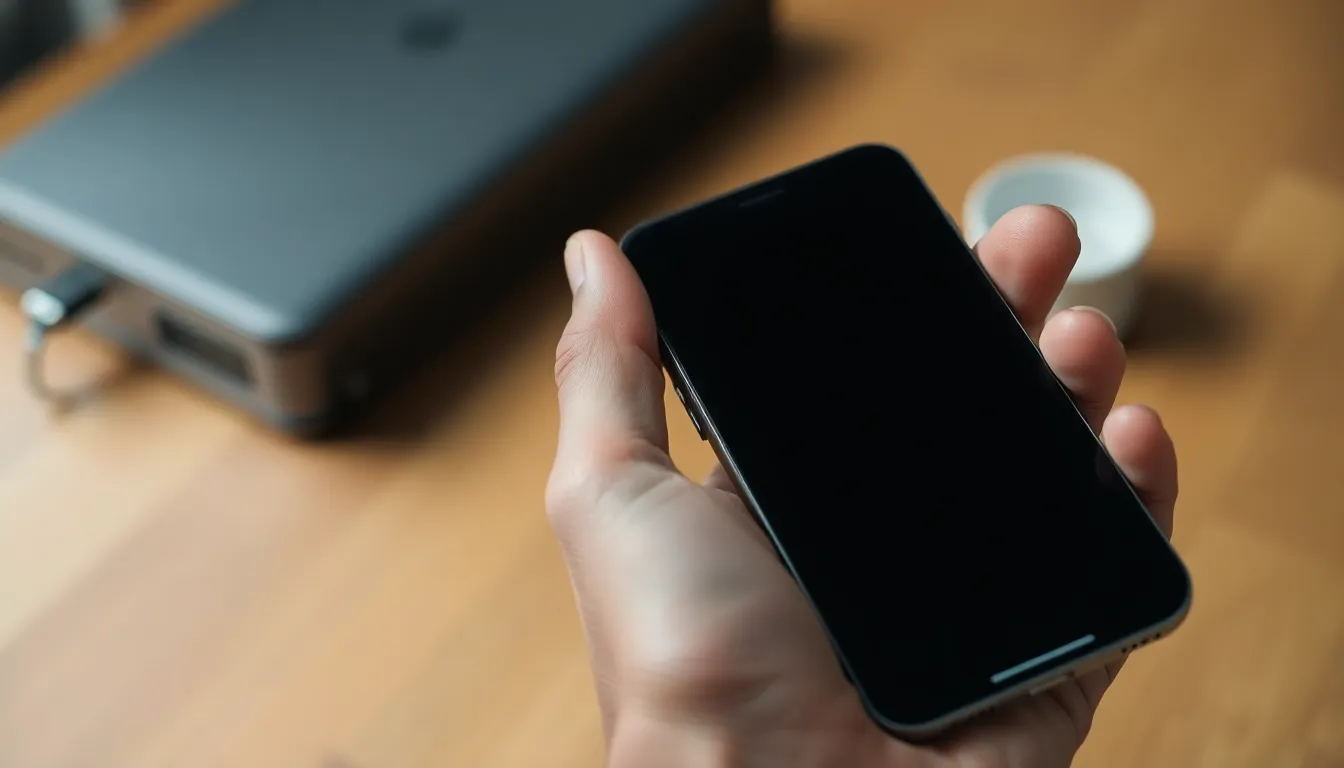Picture this: you’re in the middle of an important call or scrolling through your favorite memes, and suddenly—bam! Your iPhone decides it’s time for a dramatic exit, shutting off and turning back on like a diva on a stage. If this sounds familiar, you’re not alone. Many users find themselves scratching their heads, wondering why their trusty device has developed a flair for the theatrical.
In a world where our phones are practically an extension of ourselves, unexpected shutdowns can feel like a personal betrayal. Whether it’s a pesky software glitch or a battery issue throwing a tantrum, understanding the root cause can save users from the frustration of constant interruptions. Let’s dive into the quirks of iPhones and uncover why they might be pulling this disappearing act.
Table of Contents
ToggleCommon Reasons for iPhone Shutdowns
Unexpected iPhone shutdowns often stem from various underlying issues. Recognizing these causes can help users mitigate the problem.
Software Issues
Software glitches frequently lead to unexpected shutdowns. Incompatibility between apps or outdated operating systems contributes to these malfunctions. Faulty updates can also disrupt the device’s performance. Restarting the iPhone usually resolves minor software issues. Regular software updates ensure optimal performance and minimize bugs.
Battery Problems
Battery health significantly affects iPhone performance. Aging or degraded batteries tend to lose charge efficiency, causing sudden shutdowns. Users should check battery analytics to assess health and cycle count. When the battery’s maximum capacity drops below 80 percent, replacement may become necessary. Installing new batteries often restores stability and extends device life.
Hardware Failures
Hardware failures can manifest as unexpected shutdowns. Loose connections or damaged components disrupt power flow. Water exposure or physical damage often results in these hardware problems. Users may notice additional symptoms, such as overheating. Professional diagnostics identify hardware issues, ensuring proper repairs and restoration.
Troubleshooting Steps

Users experiencing unexpected shutdowns may benefit from several troubleshooting steps. These actions can help identify and potentially resolve the issue.
Restarting Your iPhone
Restarting the iPhone often resolves temporary glitches. To restart, press and hold the side button along with the volume button until the power slider appears. After sliding it to power off, wait 30 seconds before turning the device back on. Restarting clears temporary cache files and reinitializes device settings. Regularly doing this can prevent minor issues from escalating.
Updating Software
Keeping the iPhone’s software up to date plays a crucial role in performance. Users should regularly check for updates by navigating to Settings, then General, and selecting Software Update. Installing the latest version minimizes software bugs and enhances compatibility with apps. Updated software often includes vital security patches and improvements that help maintain device stability.
Checking Battery Health
Battery health impacts iPhone functionality directly. To check, go to Settings, then Battery, and select Battery Health. If the maximum capacity drops below 80 percent, users might consider a battery replacement. Maintaining healthy battery levels ensures the device operates efficiently without unexpected shutdowns. Regular monitoring of battery health helps preemptively address potential issues.
Preventative Measures
To prevent an iPhone from shutting off unexpectedly, users must adopt specific habits and practices.
Proper Charging Habits
Maintaining proper charging habits can extend battery life and prevent sudden shutdowns. Users should charge their devices using certified cables and chargers, as low-quality options may cause issues. Keeping the battery between 20% and 80% enhances longevity. Overcharging should be avoided, as it can lead to battery stress. Regularly examining the charging port for debris ensures proper connectivity, which can minimize disruptions in power flow.
Regular Software Maintenance
Regularly updating software keeps the iPhone running smoothly and securely. Users should check for updates at least once a month to fix bugs and improve performance. Removing unnecessary apps also helps free up resources that may contribute to slowdowns or crashes. Clearing the cache periodically boosts overall functionality and user experience. Enabling automatic updates can simplify the process, ensuring the device stays current with the latest features and fixes.
Avoiding Physical Damage
Avoiding physical damage plays a critical role in maintaining device functionality. Users should protect their iPhones with sturdy cases to absorb shocks from drops. Keeping devices away from extreme temperatures safeguards battery health and internal components. Regularly inspecting the screen and body can identify issues early and prevent costly repairs. Moreover, proper handling, such as avoiding multitasking with other devices, can help users minimize wear and tear.
When to Seek Professional Help
Recognizing when to seek professional help can make a significant difference in resolving iPhone shutdown issues. Users might encounter problems beyond simple fixes, indicating a more serious underlying cause.
Signs of Serious Problems
Frequent unexpected shutdowns signal potential hardware or battery failures. Users may notice persistent issues despite troubleshooting steps. Swelling batteries represent a critical problem that could harm other components. Overheating during charging or usage can lead to further complications if not addressed promptly. Users should also be concerned if their device experiences unresponsive behavior, such as apps crashing repeatedly or the screen freezing. Testing various charging cables or ports without improvement adds to the urgency. These signs often point to the necessity of professional diagnostics.
Warranty and Repair Options
Understanding warranty terms is essential for users with malfunctioning iPhones. Many devices come with a one-year warranty covering hardware failures and battery replacements. Apple offers repair services, which often include diagnostic checks following warranty protocols. Users can consult authorized service providers for certified repairs. Knowing that out-of-warranty options exist helps users manage repair costs effectively. Various independent repair shops may provide competitive pricing, but verifying their credibility is crucial. Recording symptoms and previous troubleshooting steps before consultations helps technicians diagnose issues faster.
Experiencing unexpected shutdowns can be frustrating and disruptive. By understanding the potential causes like software glitches or battery issues users can take proactive steps to address these problems. Regular maintenance and proper charging habits play a crucial role in ensuring device reliability.
When issues persist despite troubleshooting it’s essential to seek professional help. Authorized service providers can diagnose hardware failures and recommend necessary repairs. Staying informed about warranty terms also helps users navigate potential costs.
By adopting these practices users can enhance their iPhone’s performance and longevity. A reliable device is just a few steps away.




